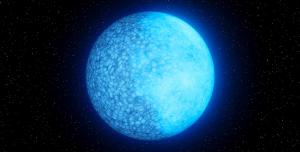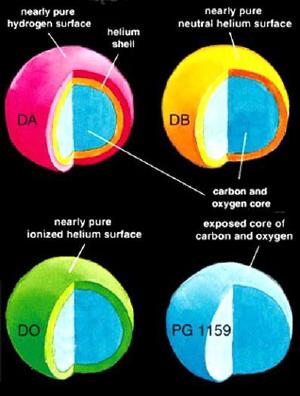Blog
Taking Sides
21 July 2023
 K. Miller, Caltech/IPAC
K. Miller, Caltech/IPACSunlike stars and those smaller than the Sun end their lives as white dwarfs. Without a continued source of energy from hydrogen fusion, these stars eventually collapse under their own weight. They would continue collapsing were it not for the pressure of electrons. As long as the remaining mass of a star is less than about 1.4 Suns, the electron pressure and gravitational pull will balance each other, creating a white dwarf.
 David Darling
David DarlingWhite dwarfs are only about as big as the Earth, but they have a star’s-worth of mass, so their surface gravity is very strong. As a result, the elements inside a white dwarf tend to settle so that the heaviest elements sink, pushing the lightest elements to the surface. This means that most white dwarfs have a surface of either pure hydrogen or pure helium, though some have an “exposed” surface of carbon or oxygen. But astronomers have recently found an unusual white dwarf that is two-faced. It has a hydrogen surface on one side and a helium surface on the other.1
It’s known as ZTF 203349.8+322901.1, and the team first noticed it while searching for highly magnetized white dwarfs with the Zwicky Transient Facility (ZTF) at Palomar Observatory. It was fluctuating in brightness with a period of about 15 minutes. Highly magnetized white dwarfs often have brightness fluctuations, but not at a regular pace. Further observations confirmed the star was rotating, with one side brighter than the other. The team then made spectral observations of ZTF 203349.8+322901.1 and found the bright side is almost pure helium, while the darker side is almost pure hydrogen.
Of course, this doesn’t explain why this white dwarf has a dual surface. It isn’t part of a binary system, so there is no obvious mechanism to cause such a striking difference. Even the team isn’t entirely sure, but one idea could be that the star has an asymmetrical magnetic field. Strong magnetic fields can interfere with the movement of elements within the star so that hydrogen would be favored on the strong magnetic side. Another idea is that the asymmetrical magnetic field interacts with the thin atmosphere of the white dwarf, allowing a sea of hydrogen to form on the strong magnetic side.
Whatever the mechanism, the discovery is exciting because it could be the white dwarf is in a transition state between a hydrogen-surfaced and helium-surfaced star. It’s thought that as white dwarfs cool, mixing of elements near the surface can stir hydrogen deeper into the star, leaving helium at the surface. This would explain why some white dwarfs have a hydrogen surface and some helium, but until now astronomers have never seen a transitioning white dwarf.
Caiazzo, I., et al. “A rotating white dwarf shows different compositions on its opposite faces.” Nature (2023). ↩︎